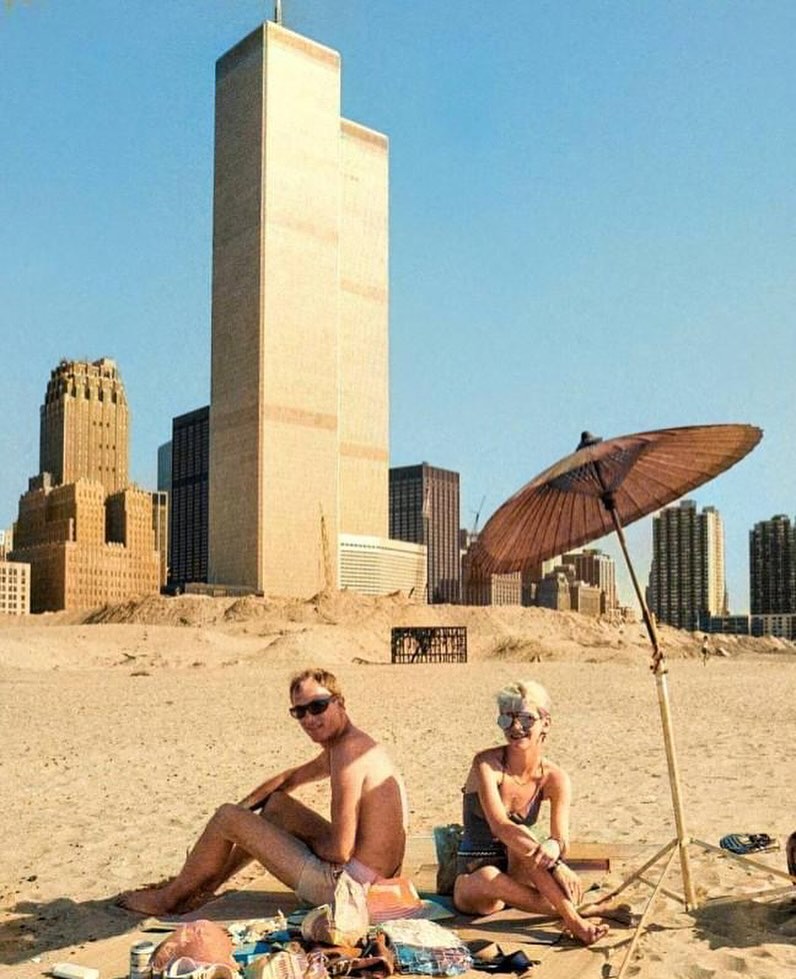Not long ago, I stumbled upon a captivating image on my phone—a snapshot of Manhattan’s iconic Twin Towers with a surprising foreground: a beach scene. People lounged on the sand, soaking up the sun as if they were on a tropical getaway. But was this image real? Could there truly have been a beach at the base of the World Trade Center?
Today, standing in Battery Park City, it’s nearly impossible to imagine such a scene. The area is now a polished urban space, buzzing with tourists, office workers, and waterfront joggers. The Statue of Liberty stands proudly in the distance, framed by Manhattan’s carefully constructed harborfront. But history reveals a lesser-known truth: there really was a beach here.

An Accidental Beach Emerges
In the mid-1970s, during the construction of the Twin Towers, something unexpected happened. As workers excavated massive amounts of earth to create the towers’ foundation, they inadvertently created a sandy shoreline along the edge of Manhattan.
This accidental beach wasn’t part of any grand city plan, but locals quickly adopted it as their own. Known informally as Battery Park Beach, it became an unexpected urban oasis. Sunbathers spread their towels on the rough, uneven sand. Volleyball games popped up on warm weekends. And for a brief moment, Manhattanites had their very own slice of the beach in the shadow of skyscrapers.
A Beach with Character
Tribeca resident Suellen Epstein fondly recalls her time at Battery Park Beach. In a now-iconic 1977 photograph, she’s seen lounging in the sun with her boyfriend.
“The sand wasn’t soft or idyllic,” Suellen explained in an interview. “It was coarse, rough, and hadn’t been shaped by ocean waves. But we didn’t care. We didn’t have the money to head out to the Hamptons. This was our escape.”
For Suellen, the beach was more than just a patch of sand—it was a brief respite from the city’s relentless energy. She described quiet moments of solitude, like the day the famous photo was taken, when she and her boyfriend had the entire beach to themselves.
A Stage for Activism and Art
Battery Park Beach wasn’t just a spot for relaxation. It became a space for cultural and social movements.
The Anti-Nuclear Rally of 1979
On September 23, 1979, over 200,000 people gathered at the beach for the largest anti-nuclear rally in U.S. history. Activists, including Jane Fonda, delivered powerful speeches, while artists like Pete Seeger and Jackson Browne performed for the crowd.
The rally marked a turning point in activism, shifting public attention from the Vietnam War to the dangers of nuclear energy after the Three Mile Island accident in Harrisburg earlier that year.
Art on the Beach: A Creative Playground
In 1980, the public arts organization Creative Time transformed the beach into a vibrant outdoor gallery known as Art on the Beach. Young, bold artists showcased their creativity on the sand, using the unique location as their canvas.
- Nancy Rubins crafted a stunning 45-foot sculpture from discarded items like lampshades and hoses. Reflecting on the experience, she said, “It was humbling to work there. I was young, and the site was enormous.”
- Agnes Denes created one of the most memorable installations with her project “Wheatfield – A Confrontation.” She planted two acres of wheat near Wall Street and the Twin Towers. The striking visual of golden wheat growing on land worth billions symbolized food scarcity, waste, and environmental carelessness.
These installations turned the beach into more than just a recreational spot—it became a place for meaningful artistic and environmental commentary.
The Beach Fades into History
By the early 1980s, change was inevitable. The area began transforming into Battery Park City, a planned community with high-rise buildings, parks, and promenades. By 2000, the sandy shoreline was gone, replaced by sleek urban development.
Then came September 11, 2001. The devastating attack on the World Trade Center changed the landscape—and the spirit—of this part of Manhattan forever.
Looking at old photos of sunbathers relaxing under the shadows of the Twin Towers now carries a bittersweet poignancy. Those carefree days feel like a fleeting memory, a reminder of a time and place that no longer exists.
A Poignant Legacy
One observer described these photos perfectly: “This picture has it all: life, death, youth, age, stillness, anticipation.” Another remarked, “So much could be said, but I’ll just look and cry.”
The images of Battery Park Beach remind us of how temporary—even accidental—beauty can be. They capture a unique moment in time when sand and skyscrapers coexisted, when activists, artists, and sunbathers all shared the same space.
Reflections on Change
Battery Park Beach was more than just a beach—it was a microcosm of Manhattan itself. It symbolized resilience, creativity, and the ability to carve moments of peace out of the chaos of urban life.
Today, as we walk along the polished waterfronts of Battery Park City, it’s worth pausing to imagine the beach that once stood there—a place where people sunbathed, artists dreamed, and movements were born.
History often hides in plain sight, and sometimes, all it takes is an old photograph to remind us of the stories beneath our feet.





